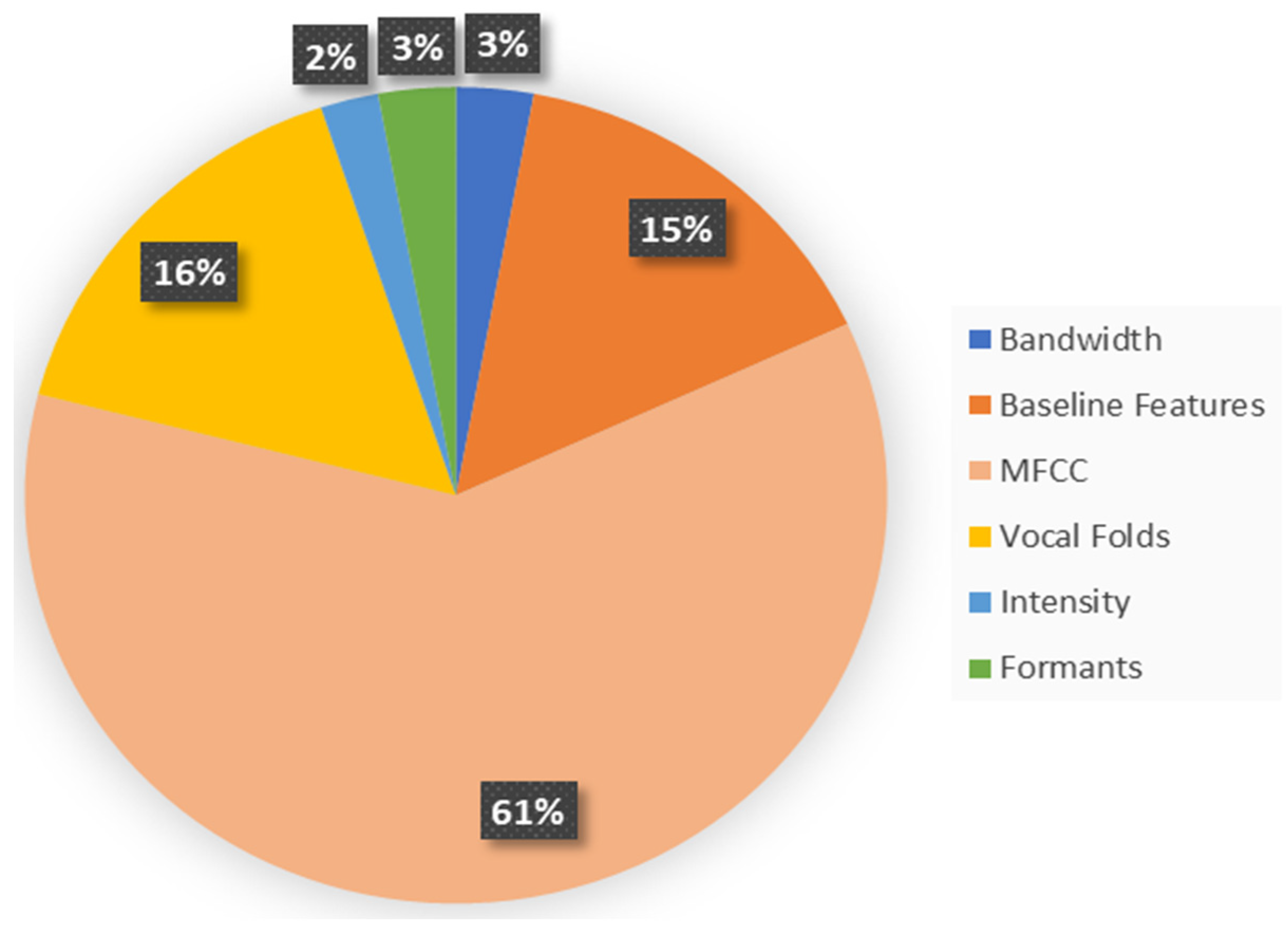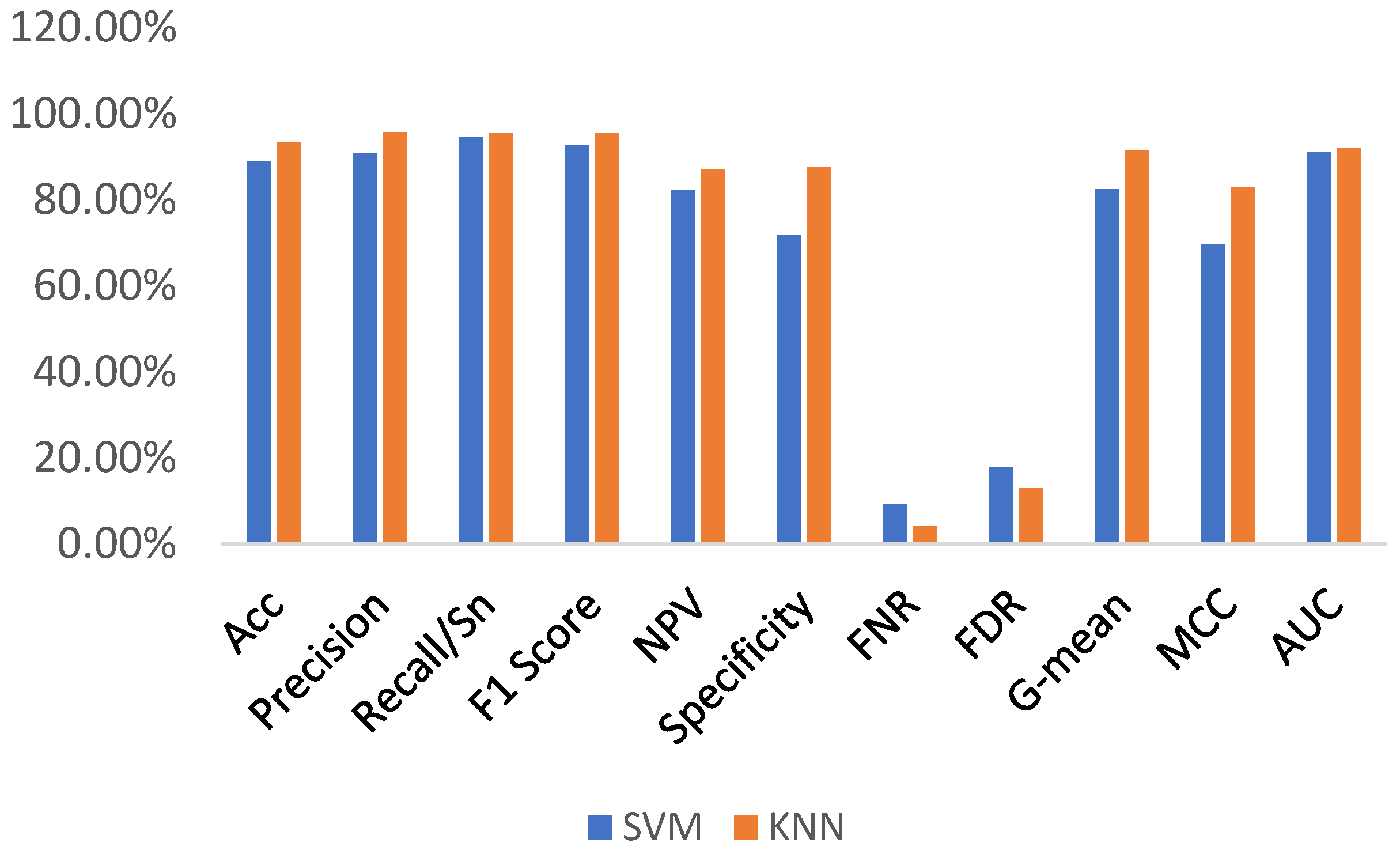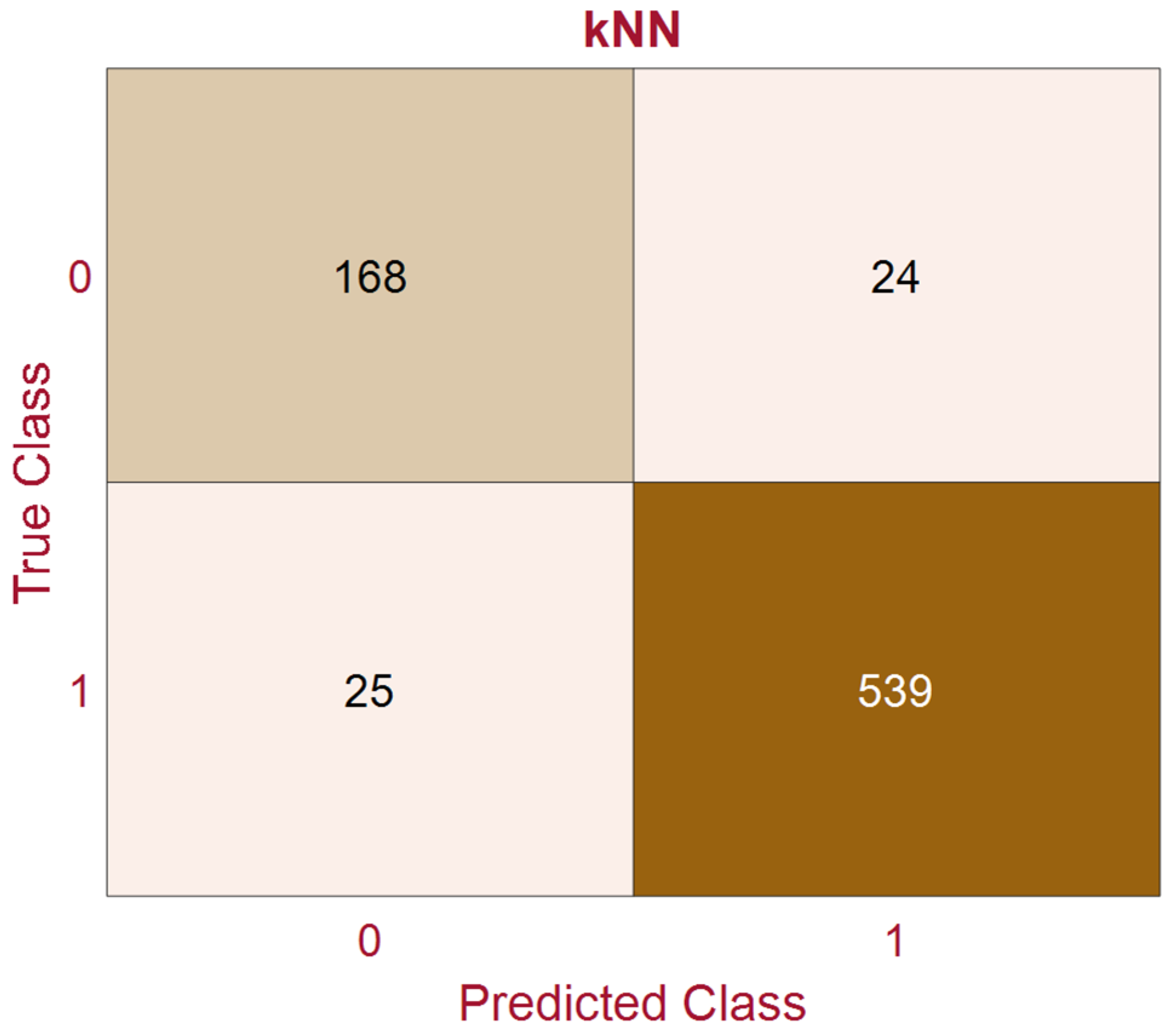Escalate Prognosis of Parkinson’s Disease Employing Wavelet Features and Artificial Intelligence from Vowel Phonation
Abstract
1. Introduction
2. Related Works
- (a)
- Employing advanced signal-processing techniques to extract acoustic features from the speech samples of patients with PD.
- (b)
- Forming feature vectors by including baseline features, intensities, formant frequencies, bandwidths, vocal fold parameters, and MFCCs.
- (c)
- Investigating the performance of two popular machine learning algorithms, SVM and kNN.
- (d)
- Improving the performance of the investigated machine learning algorithms by including wavelet-based voice features
- (e)
- A detailed performance analysis of the proposed algorithm is provided.
3. Database Description
4. Feature Analysis
4.1. Feature Vector I
4.1.1. Jitters
4.1.2. Shimmers
4.1.3. Harmonicity
4.1.4. Recurrence Period Density Entropy (RPDE)
4.1.5. Detrended Fluctuation Analysis (DFA)
4.1.6. Pitch Period Entropy (PPE)
4.1.7. Intensity Features
- Minimum Intensity: This is the lowest sound pressure level (SPL) that a voice can produce. This is often close to the threshold of hearing for an individual.
- Maximum Intensity: This is the highest SPL that a voice can produce. The physical capabilities of the vocal folds and respiratory system limit it.
- Mean Intensity: This is the average SPL over a period or a sample of voice signals. This represents the typical loudness level of a person’s voice.
4.1.8. Formants
4.1.9. Vocal Fold Parameters
4.1.10. The MFCC
4.2. Feature Vector II
5. Methods
5.1. PCA
5.2. SVM
5.3. kNN
6. Results
6.1. Results with Feature Vector I
6.2. The Results with Feature Vector II
7. Conclusions
Author Contributions
Funding
Institutional Review Board Statement
Informed Consent Statement
Data Availability Statement
Conflicts of Interest
References
- American Association of Neurosurgeons. Parkinson’s Disease. Available online: https://www.aans.org/patients/conditions-treatments/parkinsons-disease/ (accessed on 8 January 2025).
- World Health Organization. Parkinson’s Disease: Key Facts. Available online: https://www.who.int/news-room/fact-sheets/detail/parkinson-disease (accessed on 8 January 2025).
- Parkinson, J. An Essay on Shaking Palsy. J. Neuropsychiatry Clin. Neurosci. 2002, 14, 223–236. [Google Scholar] [CrossRef] [PubMed]
- John Hopkins Medicine. Parkinson’s Symptoms. Available online: https://www.hopkinsmedicine.org/health/conditions-and-diseases/parkinsons-disease (accessed on 8 January 2025).
- Braak, H.; Ghebremedhin, E.; Rüb, U.; Bratzke, H.; Tredici, K.D. Stages in the development of Parkinson’s disease-related pathology. Cell Tissue Res. 2004, 318, 121–134. [Google Scholar] [CrossRef] [PubMed]
- Islam, R.; Abdel-Raheem, E.; Tarique, M. Cochleagram to Recognize Dysphonia: Auditory Perceptual Analysis for Health Informatics. IEEE Access 2024, 12, 59198–59210. [Google Scholar] [CrossRef]
- Sakar, B.E.; Isenkul, M.E.; Sakar, C.O.; Sertbas, A.; Gurgen, F.; Delil, S.; Apaydin, H.; Kursun, O. Collection and analysis of a Parkinson speech dataset with multiple types of sound recordings. IEEE J. Biomed. Health Inform. 2013, 19, 828–834. [Google Scholar] [CrossRef]
- Logemann, J.A.; Fisher, H.B.; Boshes, B.; Blonsky, E.R. Frequency and Occurrence of Vocal Tract Dysfunction in the Speech of a large samples of Parkinson’s Patients. J. Speech Hear. Disord. 1978, 43, 47–57. [Google Scholar] [CrossRef]
- Ho, K.; Iansek, R.; Marigliani, C.; Bradshaw, J.L.; Gates, S. Speech impairment in a large sample of patients with Parkinson’s disease. Behav. Neurol. 1999, 11, 131–137. [Google Scholar] [CrossRef] [PubMed]
- Islam, R.; Tarique, M.; Abdel-Raheem, E. A survey on signal processing based pathological voice detection techniques. IEEE Access 2020, 8, 66749–66776. [Google Scholar] [CrossRef]
- Islam, R.; Abdel-Raheem, E.; Tarique, M. A study of using cough sounds and deep neural networks for the early detection of COVID-19. Biomed. Eng. Adv. 2022, 3, 100025. [Google Scholar] [CrossRef] [PubMed]
- Karimi-Rouzbahani, H.; Daliri, M. Diagnosis of Parkinson’s disease in Humans using Voice Signals. Basic Clin. Neurosci. 2011, 2, 12–20. [Google Scholar]
- Little, M.A.; McSharry, P.E.; Hunter, E.J.; Spielman, J.; Ramig, L.O. Suitability of Dysphonia Measurements for Telemonitoring of Parkinson’s Disease. IEEE Trans. Biomed. Eng. 2009, 56, 1015–1022. [Google Scholar] [CrossRef]
- Islam, R.; Abdel-Raheem, E.; Tarique, M. Voiced Features and Artificial Neural Network to Diagnose Parkinson’s Disease Patients. In Proceedings of the International Conference on Electrical and Computing Technologies and Applications, Ras Al Khaimah, United Arab Emirates, 23–25 November 2022; pp. 132–136. [Google Scholar] [CrossRef]
- Tsanas, A.; Little, M.A.; McSharry, P.E.; Ramig, L.O. Accurate Telemonitoring of Parkinson’s Disease Progression by Noninvasive Speech Tests. IEEE Trans. Biomed. Eng. 2010, 57, 884–893. [Google Scholar] [CrossRef]
- Solana-Lavalle, G.; Rosa-Romero, R. Analysis of voice as an assisting tool for detection of Parkinson’s disease and its subsequent clinical interpretation. Biomed. Signal Process. Control. 2021, 66, 102415. [Google Scholar] [CrossRef]
- Sakar, C.O.; Serbes, G.; Gunduz, A.; Tunc, H.C.; Nizam, H.; Sakar, B.E.; Tutuncu, M.; Aydin, T.; Isenkul, M.E.; Apaydin, H. A comparative analysis of speech signal processing algorithms for Parkinson’s disease classification and the use of tunable Q-factor wavelet transform. Appl. Soft Comput. 2019, 74, 255–263. [Google Scholar] [CrossRef]
- Das, R. A comparison of multiple classifications methods for diagnosis of Parkinson’s disease. Expert Syst. Appl. 2010, 37, 1568–1572. [Google Scholar] [CrossRef]
- Shirvan, R.A.; Tahami, E. Voice Analysis for Detecting Parkinson’s Disease using Genetic Algorithm and KNN Classification methods. In Proceedings of the 18th Conference on Biomedical Engineering, Tehran, Iran, 14–16 December 2011; pp. 278–284. [Google Scholar] [CrossRef]
- Senturk, Z.K. Early diagnosis of Parkinson’s disease using machine learning algorithms. Med. Hypothesis 2020, 138, 109603. [Google Scholar] [CrossRef]
- Gil, D.; Johnson, B.M. Diagnosing Parkinson’s by using Artificial Neural Networks and Support Vector Machine. Glob. J. Comput. Sci. Technol. 2009, 9, 63–71. [Google Scholar]
- Anisha, D.; Arulanand, N. Early Detection of Parkinson’s disease (PD) using Ensemble Classifiers. In Proceedings of the International Conference on Innovative Trends in Information Technology, Kottayam, India, 13–14 February 2020; pp. 1–6. [Google Scholar] [CrossRef]
- Nissar, D.R.; Rizvi, S.M.; Mir, A.N. Voice Based Detection of Parkinson’s Disease through Ensemble Machine Learning Approach: A Performance Study. EAI Endorsed Trans. Pervasive Health Technol. 2019, 5, e2. [Google Scholar] [CrossRef]
- Salama, A.; Mostafa, A.M.; Mazin, A.M.; Raed, I.H.; Arunkumar, N.; Ghani, M.K.A.; Jaber, M.M.; Khaleefah, S.H. Examining multiple feature evaluation and classification methods for improving the diagnosis of Parkinson’s Disease. Cogn. Syst. Res. 2019, 54, 90–99. [Google Scholar] [CrossRef]
- Parkinson’s Data. Available online: https://archive.ics.uci.edu/ml/datasets/Parkinsons (accessed on 8 January 2025).
- Islam, R.; Tarique, M. Classifier Based Early Detection of Pathological Voice. In Proceedings of the IEEE International Symposium on Signal Processing and Information Technology (ISSPIT), Ajman, United Arab Emirates, 10–12 December 2019; pp. 1–6. [Google Scholar] [CrossRef]
- Little, M.A.; McSharry, P.E.; Roberts, S.J.; Costello, D.A.E.; Moroz, I.M. Exploiting Nonlinear Recurrence and Fractal Scaling Properties for Voice Disorder Detection. BioMed. Eng. Online 2007, 6, 23. [Google Scholar] [CrossRef]
- Rabiner, L.; Schafer, R. Algorithms for Estimating Speech Parameter. In Theory and Application of Digital Speech Processing, 1st ed.; Pearson: London, UK, 2011; pp. 649–659. [Google Scholar]
- Taib, D.; Tarique, M.; Islam, R. Voice Feature Analysis for Early Detection of Voice Disability in Children. In Proceedings of the 2018 IEEE International Symposium on Signal Processing and Information Technology (ISSPIT), Louisville, KY, USA, 6–8 December 2018; pp. 12–17. [Google Scholar] [CrossRef]
- Yokota, K.; Ishikawa, S.; Takezaki, K.; Koba, Y.; Kijimoto, S. Numerical analysis and physical consideration of vocal fold vibration by modal analysis. J. Sound Vib. 2021, 514, 116442. [Google Scholar] [CrossRef]
- Islam, R.; Abdel-Raheem, E.; Tarique, M. Deep Learning Based Pathological Voice Detection Algorithm Using Speech and Electroglottographic (EGG) Signals. In Proceedings of the International Conference on Electrical and Computing Technologies and Applications, Ras Al Khaimah, United Arab Emirates, 23–25 November 2022. [Google Scholar] [CrossRef]
- Islam, R.; Abdel-Raheem, E.; Tarique, M. Voice pathology detection using convolutional neural networks with electroglottographic (EGG) and speech signals. Comput. Methods Programs Biomed. Update 2022, 2, 100074. [Google Scholar] [CrossRef]
- Quateri, T.E. Production and Classification of Speech Sounds. In Discrete-Time Speech Signal Processing: Principles and Practices; Prentice Hall: Upper Saddle River, NJ, USA, 2001; pp. 72–76. [Google Scholar]
- Islam, R.; Tarique, M. Phonation Attributes and Artificial Intelligence (AI) to Delineate the Progression of Amyotrophic Lateral Sclerosis (ALS): A Neurodegenerative Disorder. In Proceedings of the International Conference on Computer Engineering, Network, and Intelligent Multimedia (CENIM), Surabaya, Indonesia, 19 November 2024; pp. 1–6. [Google Scholar] [CrossRef]
- Cortes, C.; Vapnik, V. Support-Vector Networks. Mach. Learn. 1995, 20, 273–297. [Google Scholar] [CrossRef]
- Devnath, L.; Nath, S.K.D.; Das, A.K.; Islam, M.R. Selection of Wavelet and Thresholding Rule for Denoising the ECG Signals. Ann. Pure Appl. Math. 2015, 10, 65–73. [Google Scholar]
- Tan, L.; Jiang, J. Subband and Wavelet-Based Coding. In Digital Signal Processing, 2nd ed.; Academic Press: Cambridge, MA, USA, 2013; pp. 655–658. [Google Scholar]
- Mondal, M.K.; Devnath, L.; Mazumder, M.; Islam, M.R. Comparison of Wavelets for Medical Image Compression Using MATLAB. Int. J. Innov. Appl. Stud. 2016, 18, 1023–1031. [Google Scholar]
- Islam, R.; Tarique, M. Blind Source Separation of Fetal ECG Using Fast Independent Component Analysis and Principle Component Analysis. Int. J. Sci. Technol. Res. 2020, 9, 80–95. [Google Scholar]
- Islam, R.; Abdel-Raheem, E.; Tarique, M. Parkinson’s Disease Detection Using Voice Features and Machine Learning Algorithms. In Proceedings of the International Conference on Microelectronics (ICM), Abu Dhabi, United Arab Emirates, 17–20 December 2023; pp. 96–100. [Google Scholar] [CrossRef]









| Classifier | TP | TN | FP | FN | Tuned Hyperparameters |
|---|---|---|---|---|---|
| SVM | 537 | 113 | 79 | 27 | Box constraint level: 228.6744 kernel function: Gaussian Kernel scale: 10.1402 |
| kNN | 534 | 141 | 51 | 30 | No. of Neighbors: 1 Distance Metric: Euclidean Distance Weight: Squared Inverse |
| Parameters | SVM | kNN |
|---|---|---|
| Accuracy | 85.98% | 89.29% |
| Precision | 87.18% | 91.28% |
| Recall/Sn | 95.21% | 94.68% |
| F1 Score | 91.02% | 92.95% |
| NPV | 80.71% | 82.46% |
| Specificity | 58.85% | 73.44% |
| FNR | 12.82% | 8.72% |
| FDR | 19.29% | 17.54% |
| G-mean | 74.86% | 83.39% |
| MCC | 60.59% | 70.87% |
| AUC | 0.91 | 0.84 |
| Parameters | SVM | kNN |
|---|---|---|
| Misclassification cost | 106 | 81 |
| Prediction speed | 15,000 obs/s | 15,000 obs/s |
| Training time | 201.21 s | 44.01 s |
| Classifier | TP | TN | FP | FN | Remarks |
|---|---|---|---|---|---|
| SVM | 534 | 138 | 54 | 30 | Box constraint level: 0.0010072 kernel function: Quadratic |
| KNN | 539 | 168 | 24 | 25 | No. of Neighbors: 1 Distance Metric: Cosine Distance Weight: Inverse |
| Parameters | SVM | kNN |
|---|---|---|
| Acc | 88.89% | 93.52% |
| Precision | 90.82% | 95.74% |
| Recall/Sn | 94.68% | 95.57% |
| F1 Score | 92.71% | 95.65% |
| NPV | 82.14% | 87.05% |
| Specificity | 71.88% | 87.50% |
| FNR | 9.18% | 4.26% |
| FDR | 17.86% | 12.95% |
| G-mean | 82.49% | 91.44% |
| MCC | 69.68% | 82.93% |
| AUC | 0.91 | 0.92 |
| Parameters | SVM | kNN |
|---|---|---|
| Misclassification cost | 84 | 49 |
| Prediction speed | 3800 obs/s | 2200 obs/s |
| Training time | 277.92 s | 72.415 s |
| Study | Data/ Samples | Assessment Parameters | Features | Algorithm | Best Results |
|---|---|---|---|---|---|
| K. Rouzbahani [12] | PD: 23 Control: 8 Sanples: 195 | Correct Rate, Sensitivity Specificity, Error rate | 22 Voice Features | SVM, KNN, DBF | 93.82% |
| M. A. Little [13] | PD: 23 Control: 8 Samples: 195 | Correct overall, TP, TN | 17 Voice Features | SVM | 91.4% |
| R. Islam [14] | PD: 40 Control: 40 | Accuracy, Precision, Sensitivity F1 Score, Specificity, FNR, FDR G-mean, MCC | 44 Voice Features | FFNN | 85.0% |
| S. Lavalle [16] | PD: 64 Control: 64 | Accuracy, Sensitivity, Specificity Precision | 6–20 Voice Features | SVM, MLP, KNN, RF | 95.9% |
| C. O. Sakar [17] | PD: 188 Control: 64 | F1 Score, Accuracy, MCC | TQWT, MFCC | SVM-RBF | 84.0% |
| R. Das [18] | PD: 23 Control: 8 | Accuracy | 17 Voice Features | NN, DM Neural, Regression, Decision Tree | 92.9% |
| R.A. Shirvan [19] | PD: 23 Control: 8 | Accuracy | 4–9 Optimized Features | KNN | 98.2% |
| Z.K. Senturk [20] | PD: 23 Control: 8 | Accuracy | 24 Voice Features | Classification and Regression Tree, ANN SVM | 93.8% |
| D. Gil [21] | PD: 23 Control: 8 | Accuracy, Sensitivity, Specificity, PPV, NPV | Not Available | ANN, SVM | 90.0% |
| D. Anisha [22] | 252 Subjects | Accuracy, Precision, Recall, F1 Score | PCA, LDA | AdaBoost, GMB XGBoost | 94.0% |
| D. Nissar [23] | PD: 188 Control: 64 | Accuracy, Precision, Recall, F1 Score | MFCC, TQWT | Logistic Regression, Naïve Bayes, KNN RF, Decision Tree, SVM, MLP, XGBoost | 95.39% |
| A. Salama [24] | PD: 23 Control: 8 | TP, FP, Precision, Recall, ROC MAE, ACC | 23 Features | Decision Tree, Naïve Bayes, NN, RF, SVM | 99.49% |
| Proposed Model | PD: 188 Control: 64 | Accuracy, Precision, Recall/Sn F1 Score, NPV, Specificity, FNR, FDR, G-mean, MCC, AU | Baseline Features, Intensity Bandwidth, Formants MFCC, Vocal Folds, WT, TQWT | SVM, KNN | 93.5% |
Disclaimer/Publisher’s Note: The statements, opinions and data contained in all publications are solely those of the individual author(s) and contributor(s) and not of MDPI and/or the editor(s). MDPI and/or the editor(s) disclaim responsibility for any injury to people or property resulting from any ideas, methods, instructions or products referred to in the content. |
© 2025 by the authors. Licensee MDPI, Basel, Switzerland. This article is an open access article distributed under the terms and conditions of the Creative Commons Attribution (CC BY) license (https://creativecommons.org/licenses/by/4.0/).
Share and Cite
Islam, R.; Tarique, M. Escalate Prognosis of Parkinson’s Disease Employing Wavelet Features and Artificial Intelligence from Vowel Phonation. BioMedInformatics 2025, 5, 23. https://doi.org/10.3390/biomedinformatics5020023
Islam R, Tarique M. Escalate Prognosis of Parkinson’s Disease Employing Wavelet Features and Artificial Intelligence from Vowel Phonation. BioMedInformatics. 2025; 5(2):23. https://doi.org/10.3390/biomedinformatics5020023
Chicago/Turabian StyleIslam, Rumana, and Mohammed Tarique. 2025. "Escalate Prognosis of Parkinson’s Disease Employing Wavelet Features and Artificial Intelligence from Vowel Phonation" BioMedInformatics 5, no. 2: 23. https://doi.org/10.3390/biomedinformatics5020023
APA StyleIslam, R., & Tarique, M. (2025). Escalate Prognosis of Parkinson’s Disease Employing Wavelet Features and Artificial Intelligence from Vowel Phonation. BioMedInformatics, 5(2), 23. https://doi.org/10.3390/biomedinformatics5020023






